Diverted Disaster
Leads to Renaissance of
Downtown Las Vegas - An
Untold Story
Gutsy Mayor orders SECRET
removal of boxcars full
of rocket fuel parked in
the middle of the city
INSIDE VEGAS by Steve Miller
AmericanMafia.com
November 26, 2012

Click
on photo to view Discovery's "Explosions Gone Wrong"
LAS VEGAS - On Wednesday,
May 4, 1988, the city of Henderson, Nevada was almost wiped from the face
of the earth. Had it not been for the small valley surrounding the Pepcon
rocket fuel plant that diverted most of a horrendous explosion upward into
the atmosphere, what was later termed as the most powerful non-nuclear
blast ever recorded within the United States would certainly have had a
much more devastating effect.
On Thursday following
the blast, I used my Las Vegas City Councilman credentials to gain access
to the site where Pepcon once stood. I suspected there was more ammonium
perchlorate rocket fuel nearby at the adjoining Kerr Mcgee factory, and
I wanted a closer look.
Only fifty drums
containing fifty-five gallons each of ammonium perchlorate was what it
took to turn part of the southern Las Vegas valley into something resembling
Ground Zero at the old Nevada Test Site. I wanted to know if Kerr Mcgee
was still producing the powder. My suspicions were confirmed!
After driving my
truck inside the perimeter set up by the Henderson Fire Department, I followed
a dirt road around the tangled remains of Pepcon and the adjacent marshmallow
factory to access the rear of the Kerr Mcgee plant. Through the telephoto
lens on my camera, I focused on a loading dock stacked with hundreds of
yellow fifty-five gallon drums stenciled with the words AMMONIUM PERCHLORATE.
The day after only
fifty drums of the most volatile combustible known to man almost wiped
out a city, hundreds more were sitting on a loading dock waiting to be
shipped to clients around the world.
The Henderson spur
of the Union Pacific Railroad has a side track running directly into the
Pepcon and Kerr McGee plants. While I watched, a Kerr Mcgee worker opened
a locked gate to let a small swithcher engine pull three box cars into
the plant's back lot. The short train pulled up beside the loading dock
that was stacked with the yellow drums. A forklift began loading the barrels
into the boxcars.
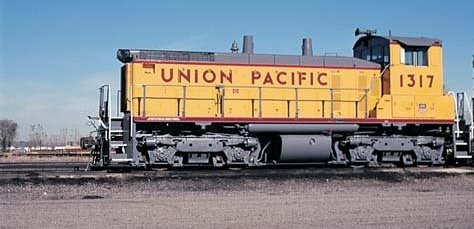 About
an hour later, I photographed the cars being pulled out of Kerr McGee and
proceed westward. I kept my camera aimed at the small train as it paralleled
Warm Springs Road. It ran dangerously close to plush Green Valley neighborhoods
and McCarran International Airport. The train soon crossed over Las Vegas
Boulevard then over Interstate 15 where it converged onto the Union
Pacific main line going north.
About
an hour later, I photographed the cars being pulled out of Kerr McGee and
proceed westward. I kept my camera aimed at the small train as it paralleled
Warm Springs Road. It ran dangerously close to plush Green Valley neighborhoods
and McCarran International Airport. The train soon crossed over Las Vegas
Boulevard then over Interstate 15 where it converged onto the Union
Pacific main line going north.
It was on its way
into Downtown Las Vegas!
I raced ahead and
watched the train pass over Tropicana Ave., then Flamingo Road as it paralleled
the Strip. Knowing it would have to pass through the 300 acre Union Pacific
rail yard downtown, I sped north on Industrial Road, crossed the tracks
at Oakey Blvd., and continued on Martin Luther King to the security gate
of the U.P. yard. There I used my credentials to gain access to the giant
yard and waited for the train to cross over the Charleston Blvd. underpass.
Within minutes the
engine pulled the three box cars onto a side track at the north end of
the rail yard behind the Plaza Hotel, and there a worker disconnected the
cars from the engine leaving them next to a lumber yard and several tank
cars labeled COMPRESSED NATURAL GAS, and PROPANE. I watched as a vagrant
walked by and flipped his lit cigarette toward the stacked lumber in the
100 degree heat.
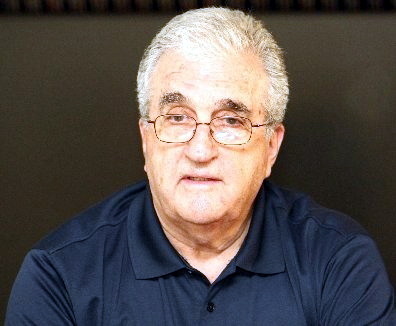 I
made an emergency call to then-Las Vegas Mayor Ron Lurie (left).
I
made an emergency call to then-Las Vegas Mayor Ron Lurie (left).
While I was describing the situation over
the phone to the mayor, Union Pacific security officers ask me to leave
the area. I showed them my City of Las Vegas badge, and waited for Lurie's
arrival. Within minutes the Mayor arrived with Fire Chief Clell West.
Lurie demanded that railroad management
come to the scene with manifests containing the contents of the three unmarked
box cars. Management soon arrived with the manifests and we were informed
that each box car contained 300 barrels of rocket fuel, a total of 900
fifty-five gallon drums, or eighteen times the number of barrels that almost
leveled Henderson! Enough rocket fuel to launch three Space Shuttles!
Chief West commented that the train cars
were parked on a rise, and if they exploded, the blast would not be directed
upward like at Pepcon, it would spread laterally wiping out the most densely
populated section of our city..
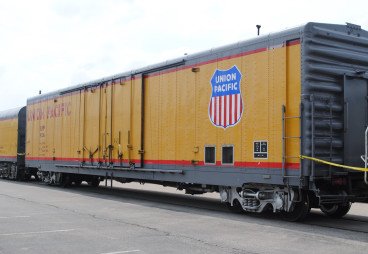 West
stated that tens of thousands of lives would be lost if another blast occurred
near dozens of huge hotels. He also stated that the nearby lumber yard
was a "tinderbox," and that the tank cars full of compressed natural gas
and propane along with the nearby box cars of ammonium perchlorate were
the makings of an unimaginable disaster.
West
stated that tens of thousands of lives would be lost if another blast occurred
near dozens of huge hotels. He also stated that the nearby lumber yard
was a "tinderbox," and that the tank cars full of compressed natural gas
and propane along with the nearby box cars of ammonium perchlorate were
the makings of an unimaginable disaster.
Mayor Lurie announced that he was going
to declare an emergency and shut down the busy U.P mainline if the box
cars were not removed within 12 hours. He then took me aside and gave me
a specific order.
"Don't tell the media. If you do, I'll
have to evacuate half the city."
I agreed to keep my mouth shut for the
time being, but told Lurie if the box cars were still there on Friday,
I would call a press conference.
While Lurie and I spoke, Chief West was
busy checking fire hydrants near the box cars. They were dry, and probably
had been for decades! Lurie was furious! West ordered fire trucks to remain
next to the box cars until they were moved. I went back to my office at
City Hall to await news of the removal of the box cars. Within the hour,
Chief West called to say they were on their way to Utah. Mayor Lurie then
informed me to be available for a meeting that evening with the CEO of
Union Pacific who was flying in from Omaha.
For over a hundred years the Union Pacific
Railroad controlled over three hundred acres of prime real estate in Downtown
Las Vegas. Three mayors; Oran Gragson, Bill Briare, and Ron Lurie had unsuccessfully
tried to convince the company to sell their valuable property and relocate
the freight yard so the city could develop the area. Union Pacific steadfastly
refused, and the site became a hobo jungle and polluted eyesore.
Now, Ron Lurie had the legal ammunition
he needed to evict Union Pacific and begin the renaissance of Downtown.
At 8 PM, I was summoned to City Hall to
meet with a man named Olsen, the CEO of Union Pacific. Standing in
the mayor's conference room were Olsen, Chief West, City Attorney Roy Woofter,
and the Mayor. Lurie opened the stand up meeting by stating he was going
to "shut down the Union Pacific main line if all hazardous materials were
not removed from the yard within one week."
Olsen tried to appease Lurie by saying
the company complied with his order to remove the three box cars of ammonium
perchlorate, and no more would be allowed to park in the yard.
Lurie told Olsen his compliance was not
enough. The Mayor said that U.P. exposed citizens of Las Vegas to grave
danger for many years. He also mentioned the inoperative fire hydrants
on their property. Lurie announced he was shutting down the rail yard,
then tersely stated, "Sell it!" The meeting abruptly ended.
The following day, Chief West called to
report that the lumber was being removed and the explosive tank cars were
off the property. Within a year, the local and international real estate
industry was abuzz with news of the offering of the availability of 300
prime acres in the center of Las Vegas. However, before the yard could
be sold, the Environmental Protection Agency required a massive decontamination.
After U.P. moved out and the ground decontaminated
from years of chemical and diesel fuel spills, trains no longer had a reason
to stop in Downtown Las Vegas because passenger service had long since
been discontinued.
.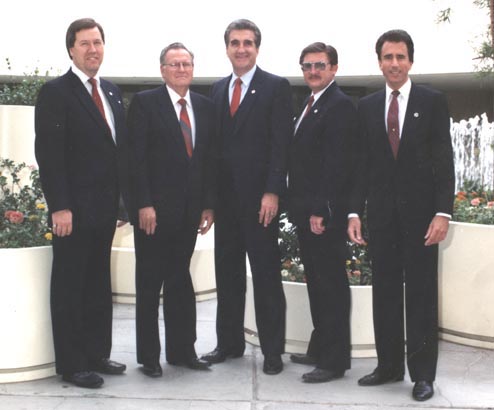
1988
LV City Council (L to R) Arnie Adamson, Wayne Bunker, Ron Lurie, Bob Nolen,
Steve Miller
Developers soon converged on the 300 acres,
and sections of land began to sell off. The first to move onto the site
was the Clark County Government Center.
Following the Government Center came the
World Market Center, Premium Outlet Mall, Molasky Corporate Center (on
the site where the three box cars were once parked), Lou Ruvo Brain Institute,
and the beautiful Smith Center for the Performing Arts, with acres remaining
for future projects.
Kerr McGee ceased
the production of ammonium perchlorate in 1998. Now trains traverse
the area at 35 MPH without stopping on their way to the new rail yard in
Apex, twenty miles north of the city.
The diversion of a disaster led to the
fulfillment of the dream of three mayors - the renaissance of an aging
downtown.
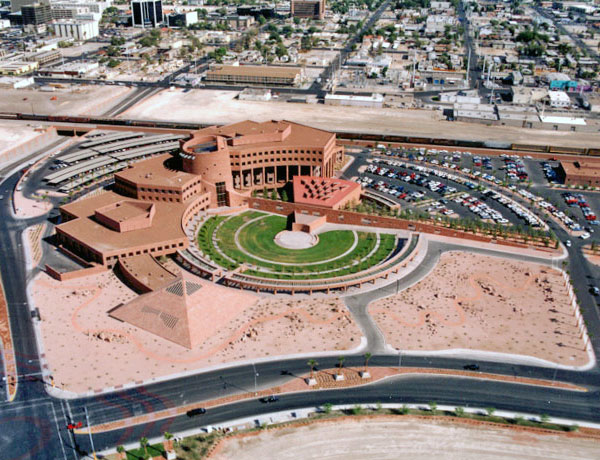
Clark County Government Center
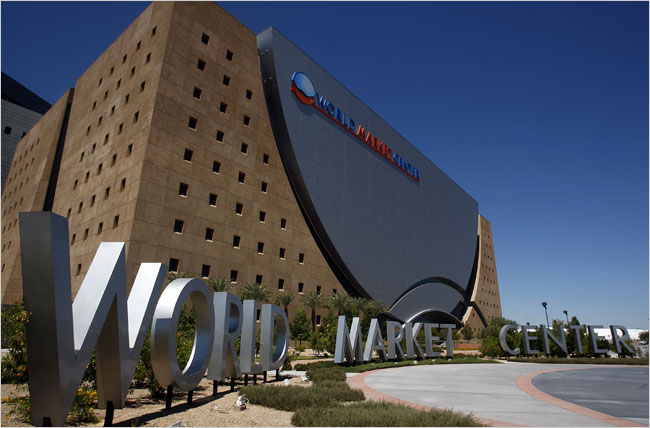
World Market Center
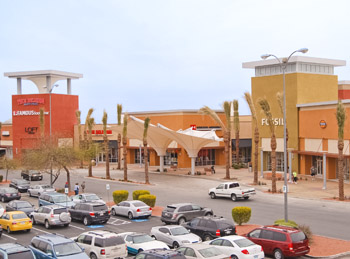
Premium Outlet Mall
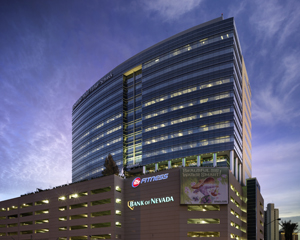
Molasky Corporate Center
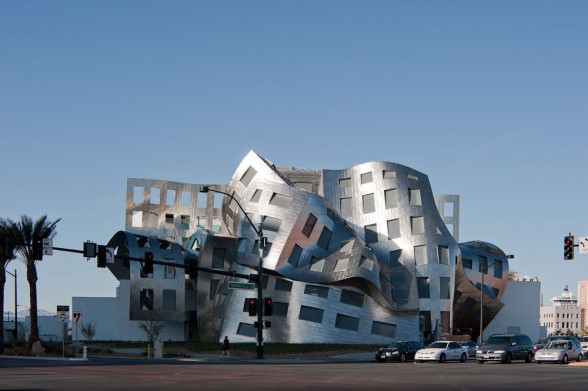
Cleveland Clinic - Lou Ruvo Brain Institute
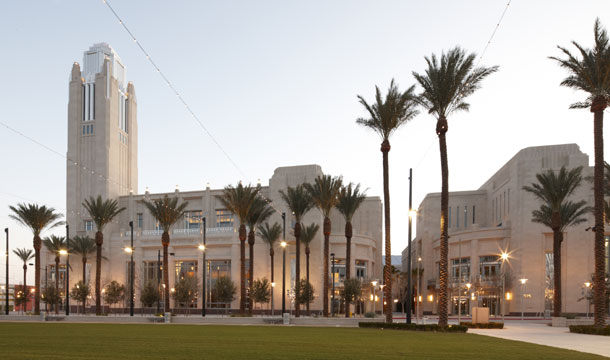
Smith Center For The Performing Arts

